Peter Meyn | |
|---|---|
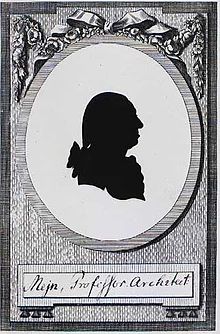 | |
| Born | 8 April 1749 |
| Died | 11 April 1808 (aged 59) |
| Nationality | Danish |
| Occupation | Architect |
| Buildings | Royal Surgical Institute, Copenhagen |
Peter Meyn (8 April 1749 - 11 April 1808) was a Danish architect. [1]
Peter Meyn | |
|---|---|
 | |
| Born | 8 April 1749 |
| Died | 11 April 1808 (aged 59) |
| Nationality | Danish |
| Occupation | Architect |
| Buildings | Royal Surgical Institute, Copenhagen |
Peter Meyn (8 April 1749 - 11 April 1808) was a Danish architect. [1]
Meyn was born in Copenhagen, the son of master joiner Anton (Anthoni) Christian Meyn (1712–82) and Helena Klefts (c. 1714–80). He studied at the Royal Danish Academy of Fine Arts where he won the small gold medal in 1767 and the large gold medal in 1768 with a project for a royal military academy. The large gold medal qualified him for the first vacant travel stipend. He worked for Caspar Frederik Harsdorff on the marble baths in Frederiksberg Palace (1770) and as executing architect on Frederick V's Chapel at Roskilde Cathedral. In 1777, when Nicolai Abildgaard had returned to Denmark, Meyn finally went abroad to further his education, spending most of the time in Paris and Rome. He returned to Denmark in 1782 and became a member of the Royal Academy in 1783. [2] [3]
In 1783, Meyn was appointed to building inspector. He was appointed to second professor at the Academy in 1783 and to first professor in 1799. He served as acting master builder (konstitueret bygmester) for the Navy in 1785–88. In 1789, he was both appointed to master builder for the City of Copenhagen and to royal master builder. [4]
1783, Meyn was married to Mette Marie Jensen (1763–1785), a daughter of Peder Jensen and Anne Marie née Reimer. After her death in 1786, he was second time married to Charlotte Amalie Avemann (1763–1830), a daughter of cellarman Johan Vilhelm Avemann and Charlotte Amalie née Svendsen.
He died on 11 April 1808 and is buried in Assistens Cemetery. He was survived by the son Johan Wilhelm Meyn (1787) and the daughter Mette Marie Meyn (1788).



Christen Schiellerup Købke was a Danish painter, and one of the best known artists from the Golden Age of Danish Painting.

Johan Frederik (Frits) Nikolai Vermehren, also known as Frederik Vermehren, a genre and portrait painter in the realist style.

Johannes Wiedewelt, Danish neoclassical sculptor. He became a court sculptor, introducing neoclassical ideals to Denmark in the form of palace decorations, garden sculptures and artifacts and, especially, memorial monuments. He was undoubtedly the best known Danish sculptor before Bertel Thorvaldsen.

Caspar Frederik (Friedrich) Harsdorff, also known as C.F. Harsdorff, was a Danish neoclassical architect considered to have been the leading Danish architect in the late 18th century.

Christian August Lorentzen was a Danish painter.
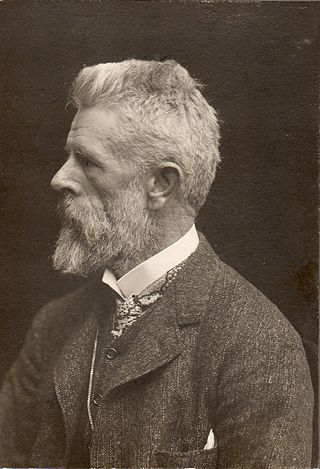
Laurits Regner Tuxen was a Danish painter and sculptor specialising in figure painting. He was also associated with the Skagen Painters. He was the first head of Kunstnernes Frie Studieskoler, an art school established in the 1880s to provide an alternative to the education offered by the Royal Danish Academy of Fine Arts.

Georg Hilker was a Danish decorative painter active during the Danish Golden Age in the first half of the 19th century. He collaborated with painter Constantin Hansen (1804–1880).
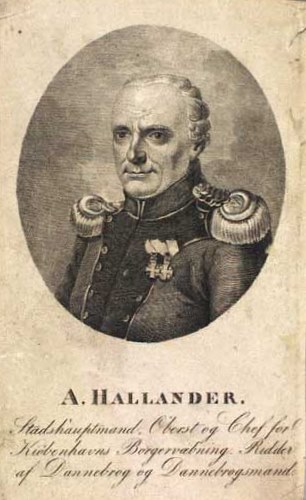
Andreas Hallander was a Danish master carpenter and architect who made a significant contribution to the city of Copenhagen. Together with the buildings of Johan Martin Quist, his classically styled apartment houses form part of the legacy of 19th-century Danish Golden Age architects who reconstructed areas of the old town which had been destroyed in the Great Fire of 1795.

Johan Martin Quist or Qvist was a Danish architect who made a significant contribution to the city of Copenhagen. Together with those of Andreas Hallander, his classically styled buildings form part of the legacy of 19th-century Danish Golden Age architects who reconstructed areas of the old town which had been destroyed in the Copenhagen Fire of 1795.
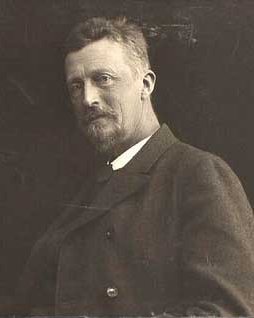
August Andreas Jerndorff was a Danish painter who is best known for his portraits.

Andreas Johannes Kirkerup was a Danish architect and master builder, one of the most significant pupils of Caspar Frederik Harsdorff. Together with architects such as Andreas Hallander and Johan Martin Quist, he played a major role in the rebuilding of Copenhagen after the Great Fire of 1795.
De Tretten, also De Tretten Kunstnere, was a grouping of young Danish artists who arranged their own exhibitions in Copenhagen from 1909 to 1912 in order to display works which would not have been accepted for exhibition by the then rather traditional Royal Danish Academy of Fine Arts.

Niels Christian Kierkegaard was a Danish draftsman and lithographer.

Frederik Vilhelm Tvede was a Danish architect.
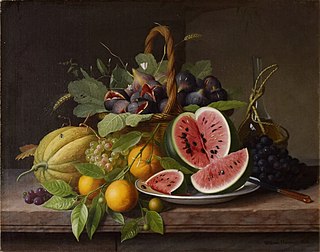
William Hammer was a Danish artist who specialized in painting still lifes of flowers and fruits.

Frederik Hansen Sødring was a Danish landscape painter and founder of an endowment.

Heinrich August Georg Schiøtt was a Danish portrait painter.
Frantz Philip Nicolai Lange was a Danish architect and master mason. He made a significant contribution to the rebuilding of Copenhagen in the years after the Copenhagen Fire of 1795. Most of his buildings have been listed on the Danish registry of protected buildings and places.
Lauritz Laurberg Thrane (1757–1809) was a Danish master mason architect and builder. He was one of the most active master builders in Copenhagen during the 1790s and 1800s, contributing to the rebuilding of the city following the Copenhagen Fire of 1795. Many of his surviving buildings have been added to the Danish registry of protected buildings and places.